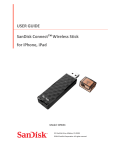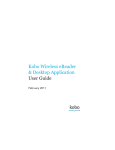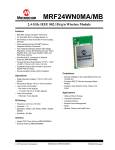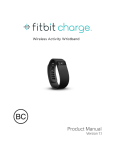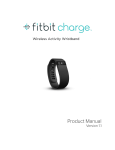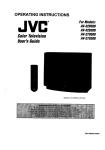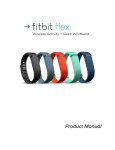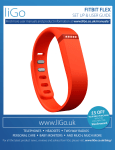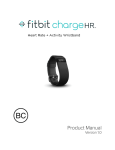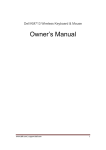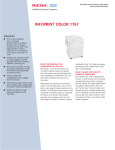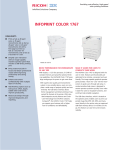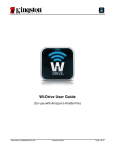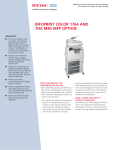Download 2 - SanDisk
Transcript
USER GUIDE SanDisk Connect Wireless Stick for Android™ Model: SDWS4 951 SanDisk Drive, M ilpitas, CA 95035 ©2015 SanDisk Corporation. All rights reserved IntroducEon GeGng Started • ConnecEng to iPhone/iPad • Charging Wireless SEck • LED Indicator ApplicaEon • Overview • File Management • Internet ConnecEvity • Camera Roll Backup • Photos • Videos • Music • Documents • Sharing & Social Network • Contact Management Personalize your Drive • Wi-‐Fi Security • Power Saving • Wi-‐Fi ConnecEon Name • ReformaGng Wireless SEck • About the Device • Firmware Update TroubleshooEng & Support • In-‐App Support • Online Support • Technical SpecificaEons • Safety and Care • Cleaning • Maintenance and Storage 2 Instructional Icons Warning Information Quick Tip 3 Introduction SanDisk Wireless Stick Overview • The flash drive reinvented for your phone, tablet and computer • Wirelessly save and access your photos, videos and files • Collect and share up to 128GB* • Stream HD movies and music to up to 3 devices at the same time • Connect wirelessly or simply plug into a USB port 4 Works with • USB 2.0 connection interface or higher • Wi-‐Fi 802.11 b/g/n 2.4Ghz capable device • Mobile device: Android version 4.2 or higher • Other Wi-‐Fi® enabled devices: a web browser, WebDAV client • PC or Mac: Windows® 10, Windows® 8, Windows 7, Windows Vista®, or Mac OS 10.6 or higher 5 Getting Started Connecting from Android 1 Plug the SanDisk Connect Wireless Stick into a computer or USB-‐AC adaptor to ensure that it’s fully charged. A full charge can take up to 2 hours. Device cannot be connected using a USB cable. 2 Install the “SanDisk Connect” app from Google Play™, Amazon Appstore, or local Android application store if not already installed. 3 Turn on the Wireless Stick by pressing and releasing the power button 6 4 Launch the “SanDisk Connect Wireless Stick” mobile app. a. Select Wireless Stick Wi-‐Fi network through the app. b. Wireless Stick Wi-‐Fi network will appear as “SanDisk Connect ######” where ###### will be a unique identifier for your specific unit. Charging Wireless Stick Plug your drive into a computer USB port or a USB AC adaptor* to charge it. * USB AC adaptor: not included with the drive 7 LED Indicator The LED indicator light on the Wireless Flash drive indicates its battery, charging and transfer status as explained below 8 Wireless Stick Status LED Status Device on White blinking Wi-‐Fi data Transfer White rapid blinking Battery charging Amber solid Low battery warning Red blinking Firmware update Color cycling 9 Application Application overview SanDisk Connect app is the companion to your Wireless Stick. Its major functions are: 1. Add photos/videos/files from the android device to the drive with the ‘+’ button. 2. Access other functions such as Auto-‐backup, “My Downloads”, settings and transfer contacts through the menu icon in the top left corner. 10 File Management Use your Wireless Stick to transfer and manage files between your Android device, PC and Mac. Connect mobile app is required to transfer files to/from Android devices. Transfer files from your Android device to the Wireless Stick 1 Use the SanDisk Connect mobile app to access your Wireless Stick. 2 Select the add file button “+”. 3 You will be prompted to “Select from Photos” by default. You can change the option from drop down menu at the top left to select from videos/music/files. 4 Select the photos/videos/music/files you want to transfer (long press also initiates select). 5 “Select Destination” to specify where to store the files on your drive. You can choose “New Folder” option to create a new folder as the destination of the file transfer on the drive. 11 Transfer files from Wireless Stick to Android 1 Use the SanDisk Connect mobile app to access your Wireless Stick. 2 Press the (options button) at the top right corner of the screen and choose “Select”. You can also initiate selection by long press on any file. 3 Select the files to be transferred. 4 Press the (options button) at the top right corner of the screen and choose “Download to Device”. Image files are added to the Android Gallery. Files downloaded to My Downloads are accessible using the SanDisk Connect app even when the drive is not connected. Transfer files between PC and Wireless Stick To transfer files between your Wireless Stick and computer simply plug the Wireless Stick into your computer’s USB port. 1 In the AutoPlay window, click Open folder to view files: 12 2 Drag and drop music, videos, photos, and documents between your computer and the Wireless Stick. 13 Transfer files between Mac computer and Wireless Stick To transfer content between your Wireless Stick and Mac computer: 1 Plug your Wireless Stick into your Mac computer’s USB port. 2 Drag and drop music, videos, photos, and documents between your MAC and your Wireless Stick. The default device name will appear as “NO NAME”. You can rename the device for easier identification. ‘Two Click’ the device name and select rename. 14 Transfer files between Wireless Stick and a device using a web browser You can transfer files between Wireless Stick and any device with a web browser. This could be useful when a mobile app is not available for a specific platform or it is not possible to install the mobile app on shared devices. For computers this will allow multiple devices to connect wirelessly via a browser instead of a direct USB connection. 1 Connect to Wireless Stick Wi-‐Fi network “SanDisk Connect ######” a. ###### will be a unique identifier for your specific unit. 2 Enter www.sandisk.com/myconnect in your web browser 3 You can now browse & download files within the browser At this time, it is only possible to browse and download content from the Wireless Stick via the web browser. There is no ability to upload content to the Wireless Stick Delete files within the App 1 Use the SanDisk Connect mobile app to access your Wireless Stick. 2 Press the (options button) at the top right corner of the screen and choose “Select”. You can also initiate selection by long press on any file. 3 Select the files to be deleted. 4 Press at the top right of the screen. 15 Search within the App 1 Use the SanDisk Connect mobile app to access your Wireless Stick. 2 In the file view, pull down the screen. 3 You will see a search box appear at the top. Enter the file name you would like to find. 4 You’ll see search results appear for any matching files. Internet Connectivity We understand how important it is for you to stay connected to Internet. Wireless Stick provides two options for your mobile device (phone/tablet) that will allow you to maintain an Internet connection while simultaneously connecting to the Wireless Stick: a local Wi-‐Fi network. Using Wi-‐Fi To configure 1 Use the SanDisk Connect mobile app to access your Wireless Stick. 2 In the app, choose Menu !Internet Connection ! Wi-‐Fi. 3 Choose your preferred network and hit OK. 16 4 The LED on the Wireless Stick will double blink to indicate the device is connected to another Wi-‐Fi network. It is recommended that you reset your Wireless Stick when the application informs you to do so. For some networks, it is recommended to close and restart your mobile application. 17 Gallery Backup You can back up your camera roll to the Wireless Stick by setting up Gallery auto-‐backup or manually backing up as needed. Automatic Backup Set-‐up once and transfer your gallery to the drive automatically each time the drive is connected. To set-‐up: 1 Use the SanDisk Connect mobile app to access your Wireless Stick. 2 On the app, go to Menu !Settings!Gallery Auto-‐Backup. 3 To change the destination of the backed up files on the drive, select the “Destination” as a folder on the drive. The default destination is “Gallery Backup” 4 Turn on the “Gallery Auto-‐Backup”. Backup may take longer than normal the 1st time. Once set up, only newly added files will be copied to the drive. Manual Backup Back up your gallery with the drive as needed using Backup Now. To back up: 18 1 Use the SanDisk Connect mobile app to access your Wireless Stick. 2 Go to Menu !Settings!Gallery Auto-‐Backup. 3 To change the destination of the backed up files on the drive, select the “Destination” as a folder on the drive. The default destination is “Gallery Backup” 4 Select “Backup Now”. 5 All the files in your gallery will be copied to the drive in the folder specified as the Destination. Backup may take longer than normal the 1st time. Once set up, only newly added files will be copied to the drive. Photos Supported file formats BMP, TIF, TIFF, JPG, PNG, GIF, XBM, ICO, TGA View 1 Use the SanDisk Connect mobile app to access your Wireless Stick. 2 The contents of the drive will appear. Browse to the folder containing your photos. 3 Tap the photo you’d like to view. 4 You can view other photos in the same folder by swiping left or right. 19 Slideshow 1 Use the SanDisk Connect mobile app to access your Wireless Stick. 2 Browse to the folder containing your photos. 3 Choose the photo you want to start with. 4 Press the (options button) at the top right corner of the screen and choose “Slideshow”. Slideshow Settings 1 While in slide show, tap on the photo once to see the options. 2 Select the settings icons in the top right. There are options for the transition type and the time duration for each photo. Videos Supported file formats WMV, AVI, MKV, MP4, MOV, FLV, MPG, RMVB, M4V, TS Playback 1 Use the SanDisk Connect mobile app to access your Wireless Stick. 2 The contents of the drive will appear. Browse to the folder containing your videos. 3 Tap the video you want to play. 20 4 You can play other videos in the same folder by swiping left or right. Some DRM-‐protected content cannot be streamed. Check with the content provider for playback restrictions. Music Supported file formats OGG, WAV, MP3, M4A Playback 1 Use the SanDisk Connect mobile app to access your Wireless Stick. 2 The contents of the drive will appear. Browse to the folder containing your music. 3 Tap the song you want to play. 4 You can play the other songs in the same folder by swiping left or right. Playback supports music purchased from iTunes. Some DRM-‐protected content is not supported. Check with the content provider for playback restrictions. While music is playing, you can continue to browse files and view photos. A music toolbar will be visible at the bottom of the screen. The toolbar allows you to pause, play, rewind, and forward. 21 Documents Supported file formats DOC, DOCX, XLS, XLSX, PPT, PPTX, PDF Viewing 1. Use the SanDisk Connect mobile app to access your Wireless Stick. 2. The contents of the drive will appear. Browse to the folder containing your documents. 3. Tap the document you want to view. 22 The SanDisk Connect mobile app supports viewing of documents only. You may be able to open these file types in other apps for additional functionality. Sharing & Social Network You can share files from your Wireless Stick in many ways including Facebook, Twitter and others from within the app. How to share 1 Use the SanDisk Connect mobile app to access your Wireless Stick. 2 Press the (options button) at the top right corner of the screen and choose “Select”. You can also initiate selection by long press on any file. 3 Select at the top of the screen. 4 Choose the desired upload/share option. 23 Contact Management Create a backup contact file and restore it when needed. This is particularly valuable when moving to a new iPhone. Backup 1 Use the SanDisk Connect mobile app to access your Wireless Stick. 2 Go to Menu ! Settings ! Transfer Contacts !Backup 3 Select the contacts to back up. 4 Select “Backup”. Restore 1 Use the SanDisk Connect mobile app to access your Wireless Stick. 2 Go to Menu ! Settings ! Transfer Contacts ! Restore 3 Choose the backup file you’d like to restore. 4 Select “Restore”. The contact restore operation may create duplicate contacts. 24 Personalize your Wireless Stick Wi-‐Fi Security You can secure the Wi-‐Fi connection enabled by your drive with a password and restrict the access. 1 Use the Connect mobile app to access your Wireless Stick. 2 Go to Menu ! Settings ! Security 3 Enable “Security”. 4 Choose and confirm the password of your choice. Any future Wi-‐Fi connection request will require this password. Power Saving The drive would go into power save mode automatically when it is inactive for a particular time period. To set this time period 1 Use the SanDisk Connect mobile app to access your Wireless Stick. 2 Go to Menu ! Settings ! Power Save Timer 3 Choose the time period. Wi-‐Fi Connection Name You can choose a name for your drive to make it easier to identify the Wireless Stick 25 1 Use the SanDisk Connect mobile app to access your Wireless Stick. 2 Go to Menu ! Settings ! Change Drive Wi-‐Fi Name. 3 In the text box, name the drive and hit OK. Reformatting Wireless Stick 1 Connect the drive to a PC/Mac computer through the USB connector. 2 Format the drive as a regular USB flash drive. The 64GB and higher capacity drive can be formatted as exFAT. 16GB & 32GB devices must be formatted as FAT32. . All data on the drive will be lost after formatting. Please back up your data before formatting. About the Device 1 Use the SanDisk Connect mobile app to access your Wireless Stick. 2 Go to Menu ! About 3 Under the About section, you can see a. Current app version b. Wireless Stick firmware version c. MAC Address of the Wireless Stick d. SanDisk Privacy Statement e. Legal terms and conditions 26 Firmware Update SanDisk continuously improves our user experience with bug fixes and enhancements. The SanDisk Connect mobile app may notify you that a new firmware is available. The app will also provide any instructions to update firmware. It is always recommended to update to the latest firmware version. 27 Troubleshooting & Support Hardware Reset To reset settings to factory default values: while the Wireless Stick is off, press and hold the power button down for about 15 seconds until the LED flashes red and green (will turn white again). The device name, password, power save time, and Internet Connectivity settings will all be reset to default values. This reset will not change the firmware version. The content on the device will remain the same. In-‐app Support Go to Menu !Help. To access the app walkthrough, getting started guide and online support. Online Support The support page for Wireless Flash Drive is available at: http://kb.sandisk.com/app/answers/detail/a_id/17367 28 Technical Specifications Form Factor: USB flash drive Memory/Storage: embedded flash memory, not user removable (available capacities: 16 GB, 32 GB, 64 GB, and 128 GB1) Battery Type: Built-‐in, non-‐replaceable rechargeable lithium polymer battery Operating Duration: Up to 4 hours of continuous usage2 Battery Charging: Over USB 2.0-‐powered connection (500mA); up to 2 hours for a full charge Simultaneous wireless usage and charge with compatible USB power adapter Wireless Connectivity: Wi-‐Fi: IEEE 802.11 b/g/n (2.4GHz) Rated power (all modes): 1.8mW/MHz Wireless Range: Up to 45m (150 feet) line-‐of-‐sight Wireless Security: WPA2 Status LEDs: Power/Battery & Wi-‐Fi activity Integrated lanyard slot Operating temperature: 32°F to 113°F (0°C – 45°C) Storage temperature: -‐4°F to 158°F (-‐20°C – 70°C) 1 1 GB – 1,000,000,000 bytes. Actual user storage less. Based on streaming 720p content at 2Mbps to one device; actual life and performance may vary depending upon usage and settings; battery not replaceable. 2 29 Operating relative humidity: 5% to 95% non-‐condensing Maximum operating altitude: 10,000 feet (3,048m) Maximum File Size: <4GB (16 GB, 32 GB versions), limited only by capacity (64 GB, 128 GB versions) Dimensions: 3.03” x 0.75” x 0.43” (77mm x 19mm x 11mm) Weight: 21.76g (0.77oz) Regulatory Statement FCC Compliance Statement: This device complies with Part 15 of the FCC Rules. Operation is subject to the following two conditions: (1) This device may not cause harmful interference, and (2) This device must accept any interference received, including interference that may cause undesired operation. Note: This equipment has been tested and found to comply with the limits of a Class B digital device, pursuant to Part 15 of the FCC Rules. These limits are designed to provide reasonable protection against harmful interference in a residential installation. This equipment generates uses and can radiate radio frequency energy and if not installed and used in accordance with the instructions, may cause harmful interference to radio communications. However, there is no guarantee that interference will not occur in a particular installation. If this equipment does cause interference to radio or television reception, which can be determined by turning the equipment off and then on, the user is encouraged to try to connect the interference by one or more of the following measures: • Reorient or relocate the receiving antenna. 30 • Increase the separation between the equipment and receiver. • Connect the equipment to a different outlet so that the equipment and receiver are on different branch circuits. • Consult the dealer or an experienced radio/TV technician for help. Important: Changes or modifications to this product not authorized by SanDisk could void the electromagnetic compatibility (EMC) and wireless compliance and negate your authority to operate the product. This product has demonstrated EMC compliance under conditions that include the use of compliant peripheral devices and shielded cables between system components. It is important that you use compliant peripheral devices and shielded cables between system components to reduce the possibility of causing interference to radios, televisions, and other electronic devices. Industry of Canada: This device complies with Industry Canada license-‐exempt RSS standard(s). Operation is subject to the following two conditions: (1) this device may not cause interference, and (2) this device must accept any interference, including interference that may cause undesired operation of the device. Le présent appareil est conforme aux CNR d'Industrie Canada applicables aux appareils radio exempts de licence. L'exploitation est autorisée aux 31 deux conditions suivantes : (1) l'appareil ne doit pas produire de brouillage, et (2) l'utilisateur de l'appareil doit accepter tout brouillage radioélectrique subi, même si le brouillage est susceptible d'en compromettre le fonctionnement. EU Declaration of Conformity Hereby, SanDisk declares that this SanDisk Connect Wireless Stick is in compliance with the essential requirements and other relevant provisions of Directive 1999/5/EC. EN 300 328 v1.7.1 (2006-‐10) EN 301489-‐17 v1.3.2 (2008-‐04) EN 62311:2008 Singapore Complies with IDA Standards DA103798 32 Brazil Este equipamento opera em caráter secundário, isto é, não tem direito a proteção contra interferência rejudicial, mesmo de estações do mesmo tipo, e não pode causar interferência a sistemas operando em caráter primário 3466-‐15-‐7909 Hong Kong Indonesia 41671/SDPPI/2015 5190 Israel 51050156 אישור תאמה . אין לבצע כל שינוי טכני בחלק יהמודולאר של המוצר 33 UAE Taiwan 注意! 依據 低功率電波輻射性電機管理辦法 第十二條 經型式認證合格之低功率射頻電機,非經許可,公司、商號或使用者均不得擅自變更頻率、 加大功率或變更原設計之特性及功能 第十四條 低功率射頻電機之使用不得影響飛航安全及干擾合法通信;經發現有干擾現象時,應立即停用,並改善 至無干擾時方得繼續使用。 前項合法通信,指依電信法規定作業之無線電通信。 低功率射頻電機須忍受合法通信或工業、科學及醫療用電波輻射性電機設備之干擾。 Malaysia 34 Saudi Arabia Complies with the CITC Technical Specification CITC Certification Number TA 03112015-‐03112016-‐11858 Thailand Safety and Care All wireless devices are susceptible to interference, which might affect the performance of a Wireless Stick. Do not switch on a Wireless Stick in restricted areas or areas where wireless devices are prohibited. When instructed to do so, switch off the Wireless Stick in restricted areas such as those near medical equipment, fuel/chemicals, or blasting areas, or when instructed to in aircraft. The Wireless Stick contains a lithium polymer battery that has been fully tested for safety. However, several precautions should be taken when using a Wireless Stick: • When a Wireless Stick is in a pocket with other metallic objects, make sure the cap is in place. • Never charge a Wireless Stick unattended. • Charge a Wireless Stick in an area away from flammable materials. 35 • Never intentionally heat a Wireless Stick in a microwave oven or dryer or place in a fire. Never use the Wireless Stick in temperatures above 60°C (140°F). • Stop using a Wireless Stick if any abnormal heat, odor, deformation, discoloration, or other abnormal condition is detected. If any liquid leaks from a Wireless Stick, wash your hands well with fresh water immediately. If liquid gets into your eyes, wash with edible oil and see a doctor immediately. The Wireless Stick is not water resistant. Do not store a Wireless Stick in extreme temperatures. High temperatures can shorten the life of the device by damaging the battery or cause warping or melting of the plastic enclosure. Cold temperatures can also shorten the life of the Wireless Stick by damaging the battery, causing plastic enclouse to crack, or causing moisture to condense on or inside the device. Keep the Wireless Stick dry. Water or other liquids can damage it. In addition, high humidity can cause condensation to form. If a Wireless Stick gets wet, turn it off, place it in a low-‐humidity environment, and allow it to completely dry. Do not store a Wireless Stick in a dusty or dirty area because mechanicals parts may be damaged or cease to work. Do not attempt to open or modify a Wireless Stick. It contains no internal serviceable parts. Attempting to modify a Wireless Stick can damage the 36 device and cause it to operate in violation of government regulations and can cause a safety concern. Do not drop, shake, strike, crush, or blend a Wireless Stick as this may damage the device. If a Wireless Stick becomes damaged, halt use immediately. Cleaning Before cleaning a Wireless Stick, disconnect it from any USB port and turn off device. If the outside of the Wireless Stick is soiled, use a cloth that has been slightly dampened with water to clean the outside. Do not allow water to enter the Wireless Stick around the power button or USB connector. 37 Maintenance and Storage The Wireless Stick contains a lithium polymer battery that needs proper care for best usage. Note that while the lithium polymer battery does not have any memory effect, proper case is required for the best usage Standard Maintenance For proper maintenance of the battery, it is best to periodically let the Wireless Stick discharge. We do not recommend keeping the Wireless Stick plugged in. For the best battery life, we recommend charging and discharging the Wireless Stick at least one a month. Long Term Storage If the Wireless Stick will not be used, it is best to keep the battery around 50% charged. To charge the battery to approximately 50%, fully discharge the Wireless Stick until it turns itself off, then let it charge for 1 hour. Store the Wireless Stick at a temperature between 20°C and 45°C (4°F and 113°F) at a relative humidity of 65% +/-‐ 20% Recycling Please recycle all the Wireless Stick packaging, if appropriate recycling facilities are available in your area. 38 When the Wireless Stick has reached the end of its useful life, return it to a recycling station in your community to prevent uncontrolled waste disposal and dispose of the battery properly. SanDisk is a trademark of SanDisk Corporation, registered in the United States and other countries. SanDisk Connect is a trademark of SanDisk Corporation. Apple, the Apple logo, iPhone, iPad, iPod Touch and Mac are trademarks of Apple Inc., registered in the U.S. and other countries. App Store is a service mark of Apple Inc. Wi-‐Fi is a registered trademark of the Wi-‐Fi Alliance. Powered by AirStash® Technology. AirStash is a registered trademark of Wearable Inc. All other trademarks are the property of their respective owners. ©2015 SanDisk Corporation. All rights reserved. 39







































